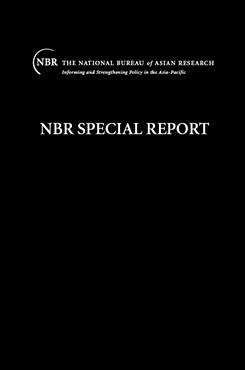NBR Special Report no. 5
Japan, the United States, and East Asia
Emerging Regional Challenges
In the first essay, Mr. Ralph A. Cossa, President of the Pacific Forum at the Center for Strategic and International Studies (CSIS), addresses the Korean nuclear crisis and assesses whether this presents an opportunity for enhanced U.S.-Japan cooperation. Mr. Cossa argues that seldom have Washington and Tokyo been so united in their views of how best to deal with Pyongyang, with both insisting on an immediate, verifiable halt to Pyongyang’s nuclear weapons programs and an immediate, full accounting and satisfactory resolution of the abductees issue. As long as Tokyo and Washington appear united in their approach toward Pyongyang, Mr. Cossa feels, it becomes easier for Seoul to follow suit.
In his essay, Dr. T. J. Pempel, Director of the Institute of East Asian Studies at the University of California at Berkeley, analyzes the future of U.S.-Japan economic relations. Dr. Pempel argues that while most trade issues have become far less bilaterally contentious, Japan’s relentless economic decline and the government’s apparent reluctance to attack its problems head-on threaten to exacerbate economic relations between Tokyo and Washington. Additionally, the U.S. shift to global unilateralism holds tremendous potential to damage U.S.-Japan economic relations. On the surface, U.S.-Japan economic relations seem to be better than ever. Yet in fact, Japan’s own economic troubles, the economic slowdown across Asia, the economic muscularity of China, the continued and rising power of private capital, as well as U.S. moves toward protectionism at home and unilateralism and military solutions abroad all present deep structural challenges that could generate economic tensions within new arenas.
Dr. Tomohito Shinoda of the International University of Japan examines the changing nature of the U.S.-Japan security partnership. Dr. Shinoda explains that the Iraq war and subsequent occupation have highlighted at least three important questions in regard to the U.S.-Japan alliance. The first concerns the geographical bounds of the alliance, which have traditionally been defined as within East Asia. The second question looks at the functional limitation of Japan’s assistance. The third involves the role of the United Nations, especially the Security Council. Dr. Shinoda expresses a concern that the asymmetric nature of the alliance creates asymmetric expectations. consequently, Dr. Shinoda argues that the alliance should be neither geographically nor functionally limited, and that UN Security Council decisions should not always be prioritized over the considerations of the bilateral alliance. Ultimately, Dr. Shinoda feels that Japan needs to reinterpret its constitution to allow the nation to exercise the right of collective self-defense.
In the final essay, Dr. Shujiro Urata, Professor of Economics at Waseda University, argues that free trade areas (FTAs) might be the key to halting what he calls the declining importance of Japan in East Asia. Dr. Urata explains how the political and economic power equations in East Asia have changed significantly, and that it is clear that China is gaining power while Japan is losing power. Partially as a consequence of these developments, the newly industrializing economies (NIEs) of Asia and members of the Association of Southeast Asian Nations (ASEAN) are reducing their trade dependence on Japan, while increasingly becoming tied economically to China. As an antidote, Japan’s conclusion of FTAs with other nations across Asia can help lead to the further deregulation and liberalization of the Japanese economy, which will encourage the free movement of people, goods, capital, and information, which are all indispensable to an economic revival.


